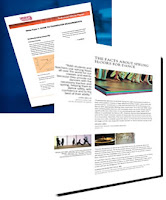
White Papers, if understood at all in the UK, probably suggest a government consultation document. But in industrial circles, more so I suspect, in America they are recognised as a means of providing a briefing such as introducing a new technology or manufacturing concept. Marketing Sherpa recently reported that "In 2008, 44% of business prospects said they are reading white papers more often than in the past. That’s an increase from the 39% who said in 2007 they were reading white papers more often. More than half of business decision-makers and influencers said they read two to five white papers per quarter." The article continues, "prospects typically download a white paper in the research phase of a buying decision. They’re looking for content that’s highly relevant to their industry or job description, and that addresses one of their biggest business problems or needs. By downloading your white paper, they’re starting a conversation that should help you gauge over time their product needs, interest level and stage in the buying cycle." So why do so few businesses include White Papers within their PR programme? White Papers are a concept we usually need to work hard with clients to accept, as they seem not to be highly valued or understood. And yet a White Paper can be a very influential tool at the research phase of the purchasing process. It not only provides the rationale but stakes your company out as experts, allowing you to capture the moral high ground. Convince a prospect that you understand the business and readers are more likely to value your business as a supplier. Interestingly LinkedIn is now offering the LinkedIn White Paper Campaign targeting professionals who could be interested in specific white papers and proposing these benefits:-
- "Target niche audiences
- Reach professional decision-makers looking for answers
- Engage your audience with relevant content
- Secure up-to-date, actionable lead information
- Contact qualified well-suited customers".
Downloading the White Paper identifies the person as a prospect, so offer a form to capture the contact information then ensure the lead is qualified and followed up with the offer of more specific product information.

No comments:
Post a Comment